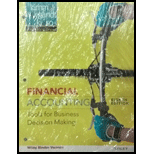
(a)
Financial Ratios: Financial ratios are the metrics used to evaluate the liquidity, capabilities, profitability, and overall performance of a company.
To compute:
(a)
Answer to Problem 13.3DIE
Current ratio for 2017
Current ratio for 2016
Explanation of Solution
Given info:
Current ratio is used to determine the relationship between current assets and current liabilities. The ideal current ratio is 2:1.
Formula:
Hence, current ratio for 2017 and 2016 is 1.53:1 and 1.66:1 respectively. It has decreased in the year 2017.
(b)
To compute: Inventory turnover ratio for 2017 and 2016
(b)
Answer to Problem 13.3DIE
Inventory turnover ratio for 2017
Inventory turnover ratio for 2016
Explanation of Solution
Given info: Balance sheet and income statement
Inventory turnover ratio is used to determine the number of times inventory used or sold during the particular accounting period.
Formula:
Average inventory for 2016 and 2015 is determined as follows:
Average inventory for 2016
Average inventory for 2015
Hence, inventory turnover ratio for 2017 and 2016 is 2.25 times and 2.44 times respectively. In the year 2016, it has decreased.
(c)
To compute: Profit margin for 2017 and 2016
(c)
Answer to Problem 13.3DIE
Profit margin ratio for 2017
Profit margin ratio for 2016
Explanation of Solution
Profit margin ratio is used to determine the percentage of net income that is being generated per dollar of revenue or sales.
Formula:
Hence, profit margin ratio for 2017 and 2016 is 7.7% and 4.5% respectively. This ratio has increased because net income is increased.
(d)
To compute: Return on assets for 2017 and 2016
(d)
Answer to Problem 13.3DIE
Return on assets ratio for 2017
Return on assets ratio for 2016
Explanation of Solution
Return on assets determines the particular company’s overall earning power.
Formula:
Average total assets are determined by dividing opening and closing total assets by 2. It is calculated as follows:
Average assets for 2017
Average assets for 2016
Hence,
(e)
To compute: Return on common
(e)
Answer to Problem 13.3DIE
Return on stockholders’ equity for 2017
Return on stockholders’ equity for 2016
Explanation of Solution
Explanation
Rate of return on stockholders’ equity is used to determine the relationship between the net income and the average common equity that are invested in the company.
Formula:
Average common stockholders’ equity is determined by dividing opening and closing total common stockholders’ equity by 2. It is calculated as follows:
Average common stockholders’ equity for 2017
Average common stockholders’ equity for 2016
Hence, rate of return on stockholders’ equity for 2017 and 2016 is 28.4% and 15.9% respectively.
(f)
To compute: Debt to asset ratio for 2017 and 2016
(f)
Answer to Problem 13.3DIE
Debt to Total Assets Ratio for 2017
Debt to Total Assets Ratio for 2016
Explanation of Solution
Explanation
Debt to asset ratio is used by the company to determine how well the company is able to survive the losses without damaging the creditors’ interest. It is determined by dividing total debt and total assets.
Formula:
Total debt is determined by adding total current liabilities and total long-term liabilities.
Total debt for 2017
Total debt for 2016
Hence, debt to total assets for 2017 and 2016 is 28.4% and 15.9% respectively.
(g)
To compute: Times interest earned for 2017 and 2016
(g)
Answer to Problem 13.3DIE
Times interest earned ratio for 2017
Times interest earned ratio for 2016
Explanation of Solution
Times - interest earned ratio quantifies the number of times the earnings before interest and taxes can pay the interest expense.
Formula:
Income before income tax and interest expense is the sum of income before tax and interest expense.
Income before income tax and interest expense for 2017
Income before income tax and interest expense for 2016
Hence, times interest earned ratio for 2017 and 2016 is 17.8 times and 12 times respectively. Company’s ability towards payment of interest has increased in the year 2017.
Want to see more full solutions like this?
Chapter 13 Solutions
Bundle: Financial Accounting: Tools for Business Decision Making 8e Binder Ready Version + WileyPLUS Registration Code
- General Accounting Questionarrow_forwardSea Harbor, Inc. has a marginal tax rate of 35 percent and an average tax rate of 22 percent. If the firm earns $79,500 in taxable income, how much will it owe in taxes? a. $10,335. b. $16,695. c. $17,490. d. $27,030. e. $27,825.arrow_forwardPlease give me true answer this financial accounting questionarrow_forward
 Financial AccountingAccountingISBN:9781305088436Author:Carl Warren, Jim Reeve, Jonathan DuchacPublisher:Cengage Learning
Financial AccountingAccountingISBN:9781305088436Author:Carl Warren, Jim Reeve, Jonathan DuchacPublisher:Cengage Learning Cornerstones of Financial AccountingAccountingISBN:9781337690881Author:Jay Rich, Jeff JonesPublisher:Cengage Learning
Cornerstones of Financial AccountingAccountingISBN:9781337690881Author:Jay Rich, Jeff JonesPublisher:Cengage Learning Managerial Accounting: The Cornerstone of Busines...AccountingISBN:9781337115773Author:Maryanne M. Mowen, Don R. Hansen, Dan L. HeitgerPublisher:Cengage Learning
Managerial Accounting: The Cornerstone of Busines...AccountingISBN:9781337115773Author:Maryanne M. Mowen, Don R. Hansen, Dan L. HeitgerPublisher:Cengage Learning Managerial AccountingAccountingISBN:9781337912020Author:Carl Warren, Ph.d. Cma William B. TaylerPublisher:South-Western College Pub
Managerial AccountingAccountingISBN:9781337912020Author:Carl Warren, Ph.d. Cma William B. TaylerPublisher:South-Western College Pub Financial And Managerial AccountingAccountingISBN:9781337902663Author:WARREN, Carl S.Publisher:Cengage Learning,
Financial And Managerial AccountingAccountingISBN:9781337902663Author:WARREN, Carl S.Publisher:Cengage Learning, Financial AccountingAccountingISBN:9781337272124Author:Carl Warren, James M. Reeve, Jonathan DuchacPublisher:Cengage Learning
Financial AccountingAccountingISBN:9781337272124Author:Carl Warren, James M. Reeve, Jonathan DuchacPublisher:Cengage Learning





